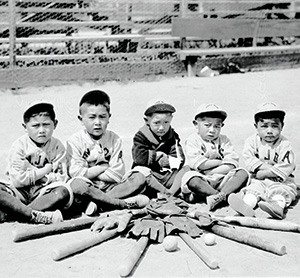

After 15 years and nearly 500 pages of resulting material, the definitive history of Japantown has finally emerged. San Jose Japantown: A Journey is a vibrant, gargantuan volume, with myriad threads of history from every nook and cranny between Hedding and Empire, from First Street to Tenth Street. The book covers the time period from the 1890s until just a few years ago. On Saturday, Nov. 29, a book launch party will unfold at 1pm at the San Jose Buddhist Church Betsuin.
Curt Fukuda and Ralph Pearce are officially listed as the authors, but countless others contributed photographs and research information over the last several years. Readers will take away the essence of what’s been a dramatic journey for so many residents, those who’ve come and gone, or even returned, like Fukuda himself.
On another level, the “journey” in question might refer to the process by which the book came to fruition. In 1999, Fukuda took a multimedia class at Foothill College. At the time, “multimedia” was still a ridiculous buzzword raging throughout parts of the high-tech universe and virtual reality was still understood as a potential new technology that might someday rule the world. Along with Jim Nagareda, Fukuda decided to work on a multimedia project documenting San Jose’s Japantown.
“Back then, it’s not like the Google cars now, that have the spinning cameras,” Fukuda said. “Jim and I would, like idiots, go out and stand in the middle of the street with cameras on these tripods with special heads to take panoramas. By hand, we’d take pictures, 360 degrees, and we went all around Japantown.”
Historically speaking, that was also the era of the interactive CD-ROM. (Remember that?) Fukuda harbored grand-scale plans to bring J-Town to the virtual world.
“We were thinking, let’s put it on a CD-ROM, put it in a jewel case and let’s put in a little eight-page booklet to go with it,” he said. “I also came up with the idea: ‘Wouldn’t it be great if, as you navigated on your computer, through the streets of Japantown, you got to click on a building, and it would open up a little movie, and in the movie, someone would be telling you about the history of the building.'”
As the years went by, more interested parties came on board and more interviews piled up. By the time 2003 came around, even with a working virtual reality prototype, everyone decided a regular, old-fashioned book was the way to go. Fukuda became the lead writer and then Pearce, who toils by day in the California Room at the MLK main library, came on board a few years later. Pearce had already written another book, From Asahi to Zebras: Japanese American Baseball in San Jose, California. Together, their efforts resulted in gorgeous, rip-roaring tome of history.
I cannot even get close to a summary of the book’s contents, but Fukuda said the radical exploits in social justice during the 1970s were some of the threads that surprised him the most. Asians for Community Action (ACA) represented a serious activist movement during that decade.
“Even people who know Japantown don’t know the role this group really played,” Fukuda said. “They really brought a lot of youthful energy.”
When the art gallery WORKS/San Jose first moved to the corner of Sixth and Jackson, it brought with it avant-garde performances, including a notorious performance by the legendary father of body modification, Fakir Musafar. If residents of the complex now at that corner only knew what sordid activities once transpired at that same intersection, what would they think?
“I couldn’t get the body piercing photo into the book,” Fukuda said, with a tinge of disappointment.
Pearce said he enjoyed taking part because he thrives on documenting forgotten stories. Japantown is filled with them and the entire rest of the city doesn’t seem to care. “I always get drawn to stuff that seems like it’s being ignored,” Pearce told me. “People say, ‘Why don’t you write about the Quicksilver Mines and all this other stuff,’ but you know, people are doing that already. I want to save stuff, that if I didn’t get involved, it wouldn’t be saved.”



